VISA Information
VISA Information
Busan, a bustling city of approximately 3.4 million residents, is located on the southeastern tip of the Korean peninsula. The size of Busan is 770.07km² which is only 0.8% of the whole landmass of the Korean Peninsula. The natural environment of Busan is a harmonious relationship of mountains, rivers and sea. Its geography includes a coastline featuring superb beaches and scenic cliffs, mountains which provide excellent hiking and extraordinary views with hot springs scattered throughout the city. Busan enjoys four distinct seasons and a temperate climate that never gets too hot or too cold.
Busan is the second largest city in Korea. Its deep harbor and gentle tides have allowed it to grow into the largest container handling port in the country and the fifth largest in the world. The city's natural endowments and rich history have resulted in Busan's increasing reputation as a world class city for tourism and culture, and it is also becoming renowned as a hot spot destination for international conventions.
Location
Geographically, Busan has the Straits of Korea to its south; Ulsan to the north; and Gimhae to the West. Cities that share almost the same latitude with Busan include Jinhae and Gwangju in Korea, as well as Tokyo, Algiers and Oklahoma City internationally. Busan is eight hours ahead of GMT. As for its geopolitical location, the city is located at the Southern tip of a strip that connects Asia, Siberia and Europe. It also serves as a main gateway to the Pacific Ocean. This strategic location places the city at the center of international sea transportation.
Climate

Busan has a maritime climate characterized by being cool in the summer and warm in the winter since it is a city bordering the ocean. From March to May, it is spring time in Busan. It is relatively warm although you may find it chilly when the wind blows.From June until August, it is summer season where the weather will be humid and hot. During this season, it also a raining season so it rains a lot. From September to November, Busan is often blessed with a clear sky. There is a large difference in temperature between day and night. Typhoons might occur during this period. From December to February during winter, it is windy, cold, and dry. The average temperature ranges from 0°C to 29°C. It can drop to below -5°C or hit above 32°C in rare cases.
Tourist Attractions
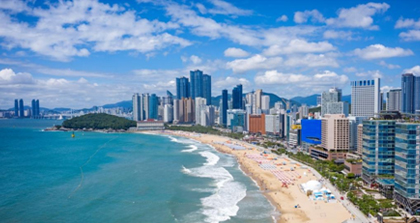
-
Haeundae Beach
More Information
Going beyond Busan, Haeundae is beloved throughout the country as a vacation spot. It teems with so many attractive places such as 5-star hotels, restaurants, and an aquarium. In addition, it boasts outstanding popularity and receives more than million tourists annually, particularly in the summer season. Haeundae is a must-visit site when you visit Busan.
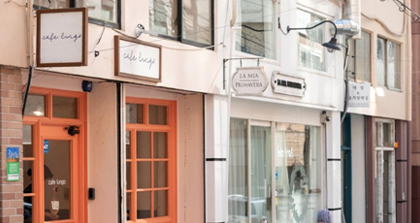
-
Jeonpo Cafe Street
More Information
It is a place full of things to see, eat, and buy. Not far from Seomyeon 1beonga, one of the busiest streets in Busan, you will be able to find a quiet cafe street filled with about 30 unique coffee shops beautifully decorated. It is worth noting that originally, in Bujeon-dong and Jeonpo-dong, there was also a street full of hardware shops selling industrial supplies and tools.
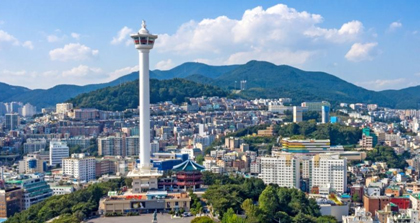
-
Yongdusan Park
More Information
The 120m high Busan Tower commands a particularly impressive view of Busan. It is also loved as a break area downtown where various programs and events are held each season. Please note that it can be easily reached by using the escalator leading to the park which was installed on Gwangbok-ro Street.
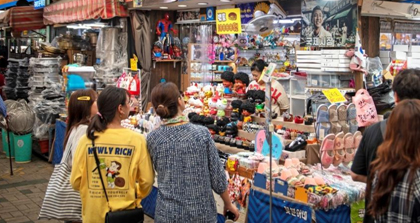
-
Gukje Market
More Information
It is an enormous market located in Nampo-dong, which can be roughly divided into several subsections, such as Food Street, Youth Street, Everything Street, Arirang Street, and Vintage Street. It is also known as “Dottegi Market.” “Dottegi Market” refers to a disorderly, bustling, and unusual flea market where people used to sell off second-hand goods and junk at wholesale, retail, or under the table prices. The name originated from the fact that when Japanese people rushed back home following the independence of Korea, their leftover belongings went up for bidding. It has been said that there were lucky people who received a financial windfall at that time. One more thing to keep in mind is that this place is known as the heaven of snacks because each cranny is full of street snacks, including spicy glass noodles, sweet red bean porridge, and spicy rice cakes.
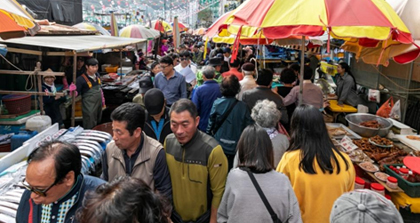
-
Jagalchi Market
More Information
Jagalchi Market is famous for the slogan, “Come, See, and Buy.” It is a place where you can feel the unique friendliness of Busan. A selected fish can be sliced on the spot for you to eat raw. Watching a flopping fish cleaned into sliced raw fish is in itself an amazing scene. Jagalchi Market is a must-see place for tourists.
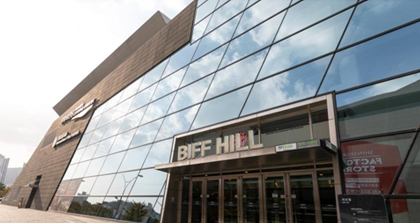
-
Busan Cinema Center
More Information
The heart of Busan as a representative film city of Asia is the Busan Cinema Center in Centum City. It’s comprised of different multi-purpose halls such as three exclusive theaters, an outdoor stage, 'BIFF Hill' and 'Cinemountain.’ The opening and closing ceremonies of the Busan International Film Festival as well as red carpet events are held here.
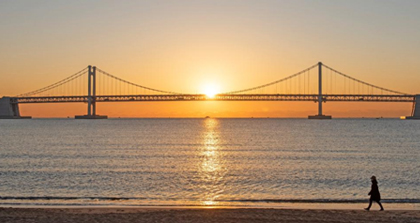
-
Gwangalli Beach
More Information
Gwangalli Beach is known for its breathtaking night view with Gwangandaegyo Bridge stretching across the ocean in the background. You can find differently themed streets around Gwangalli Beach featuring a variety of concerts and things to enjoy in all seasons, including the annually held Busan Fireworks Festival.

-
Millak Waterside Park
More Information
It is Korea’s first waterfront park, a place of relaxation where you can enjoy the ocean view, located between Haeundae and Gwangalli.
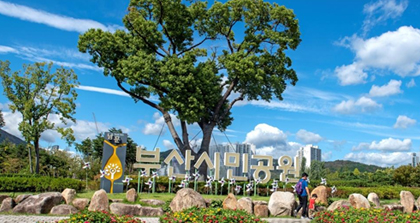
-
Busan Citizens Park
More Information
It is Busan’s largest urban park with a size of 520,000㎡, equipped with woodland paths, walking trails, a labyrinth garden, a sandy beach within the park, a culture and arts village, a book cafe in the forest, children’s play areas, and a large grass square. In particular, a tunnel fountain, musical fountain, and high fountain soaring into the sky are the must-see attractions available only at Busan Citizens Park.
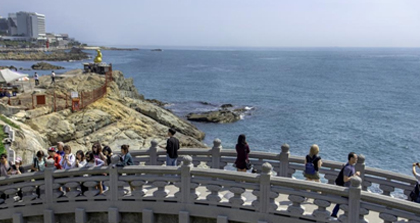
-
Haedong Yonggungsa Temple
More Information
The Portrait of Putai marking the start of the 108-step stairway leading into the main temple site is stained with handprints because of the rumor that touching the belly of the beloved Buddhist deity in this portrait can make women bear and give birth to sons.
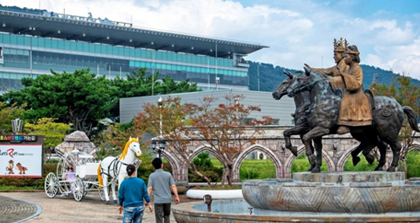
-
Let's Run Park Busan
More Information
Let's Run Park Busan Gyeongnam is a composite leisure space where everyone can learn and experience everything about horses and enjoy various other pleasures. Visitors who have a particular desire for horse riding can enjoy lessons that they will never forget.
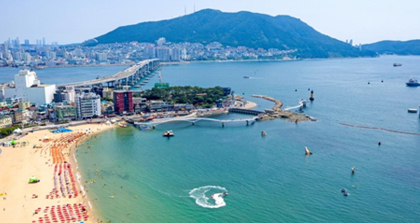
-
Songdo Beach
More Information
Songdo Beach is the first designated swimming beach in Korea. A special attraction of Songdo finally came up. It is Songdo Marine Cable Car that is restarting its operation at June 21st 2017, in 29 years. It’s the first marine cable car across the sea and the sky around the beach. Also, you can enjoy many things to see over the sea such as SkyWalk, Songdo Coast Bolle-gil
Walkway, Taejongdae, Huinyeoul Culture Village, Namhang Bridge as well as Songdo Beach.

-
Taejongdae Recreation Area
More Information
Taejongdae Park, located at the southernmost point of Yeongdo Beach, is named after King Taejong Muyeol of Silla, who is said to have visited the area often for the beautiful view of the sea. And rightly so, Taejongdae Park has the reputation of offering the best and the clearest view of the sea in Busan. On clear days, visitors can even see the Tsushima Island of Japan in the horizon.
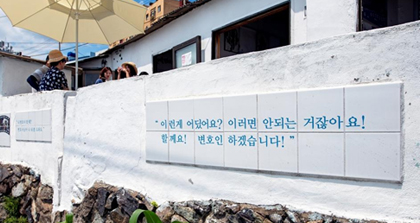
-
Huinnyeoul Culture Village
More Information
The origins of Huinnyeoul Culture Village can be traced to the refugee communities that sprang up in Busan after the end of Korean War. Huinnyeoul Culture Village is one of the best villages to see the coast of Busan.
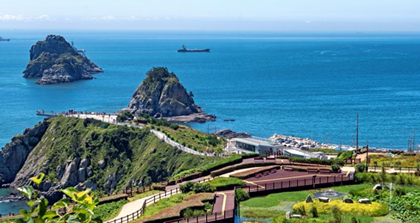
-
Oryukdo Skywalk
More Information
Taking in a thrilling feast of waves 30m below, the transparent U-shaped floor of the Oryukdo Skywalk makes people feel as if they were fl ing in the sky. As a junction where the East and South seas meet, this site is emerging as a new attraction and has been steadily attracting tourists since its opening in 2013. Be sure not to forget to wear your overshoes when walking on this bridge, as they are required and provided at the entrance.
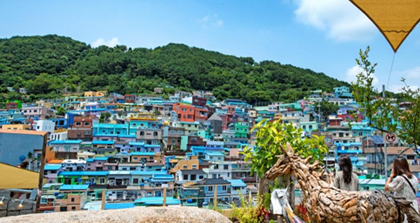
-
Gamcheon Culture Village
More Information
Gamcheon Culture Village is often known as the “Machu Picchu of Korea.” The houses on the terraced hillside, labyrinth-like alleyways and stamp tour will make you want to visit the village again and again.
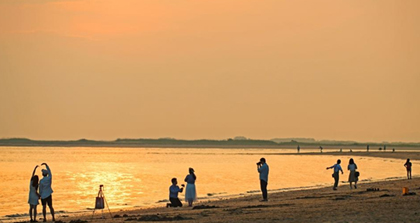
-
Dadaepo Beach
More Information
The wide beach with shallow water is good as a summer resort for families. The sunset dyeing the sky of Dadaepo red is also a source of pride that is hard to miss.
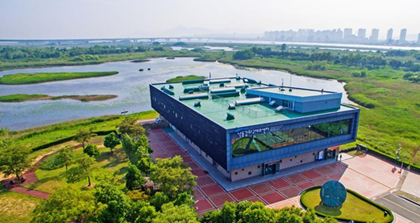
-
Eulsukdo Bird Sanctuary
More Information
What if a place, once only studied in class, was spread out before your eyes? Eulsukdo is a spot where you can see the Nakdong Delta at the mouth of the Nakdonggang River. The nearby Nakdong Estuary Eco Center is the perfect place to enjoy the flapping of migratory birds through large glass windows, along with the glow of the setting sun. Spacious internal facilities in conjunction with ample parking have drawn positive reviews from tourists. Please note that the center is closed on Mondays.
The Republic of Korea, hereinafter referred to as Korea, is a country visited by approximately 10 million international travelers every year. With its long history and unique culture and traditions, the country has a lot to offer to its visitors. Continue reading to learn some more general information about Korea before visiting.
Where is Korea?

The Korean peninsula, roughly 1,030 km long and 175 km at its narrowest point, has a total land area of 100,033 km2 and is located in Northeast Asia. With Seoul as its capital city, Korea is neighbored by Japan to the east, China to the west and the Democratic People’s Republic of Korea (North Korea) across the northern border.
Language
THangeul (한글), Korea’s official alphabet, was first invented by King Sejong during the Joseon Dynasty. Originally called Hunminjeongeum (훈민정음), the language was conceived in 1443, and further promulgated by the King in 1446. At the time of its inception, the language consisted of 17 consonants and 11 vowels however, since then, 3 of the originally established consonants and 1 vowel have fallen into disuse bringing the total number of characters to 24. Syllables are formed by the selective combination of vowels and consonants to create words.
Business Hours
Government office hours are usually from 9:00 to 18:00 on weekdays. Banks are open from 9:00 to 16:00 on weekdays. Most stores are open every day from 10:30 to 20:00, including Sundays.
Currency & Exchange
The currency of Korea is the South Korean won, or won for short. The currency sign for the won is ₩. There are currency exchanges at the airports and select locations around Seoul and elsewhere, but the best way to get money all over Korea would be through ATMs. You can find ATMs at airports, subway stations and most convenient stores. You would use them the same way you would at home and there will likely be a transaction fee of about $3-$5. It is generally a good idea for all travelers to bring at least $100 USD on them that they can exchange when they arrive in Korea in case they have issues with their card

Tip & Tax
Service charges are included in your bill for rooms, meals, and other services at hotels and upscale restaurants. Koreans occasionally do tip when they are especially pleased with the service they receive. Foreign tourists can receive nearly 10 % VAT refunds for purchases at Duty Free shops. Goods must be taken out of Korea within three months of purchase to be eligible for a tax refund. Visitors can receive a refund on a receipt for a minimum purchase of KRW 50,000 (around USD 43). To receive this refund, present receipts with the purchased goods at the customs clearance desk at Incheon International Airport when departing.
Electricity Info
The standard electricity supply is 220 volts AC/60 cycles. Most hotels may provide outlet converters for 110 and 220 volts. Participants are recommended to check with the hotel beforehand.
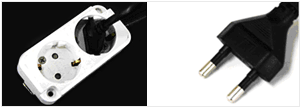
Emergency Phone Numbers
- 1339: Medical Emergency
- 119: Emergencies for Fire, Rescue & Hospital Services, First Aid Services
- 112: Police
Useful Websites
Korea Tourism Organization
Go
Seoul Tourism Organization
Go
Korea Immigration Service
Go
Ministry of Foreign Affairs and Trade
Go
Incheon International Airport
Go
Foreign nationals entering Korea are required to have a valid passport and a Korean visa issued by the Korean Embassy or consular offices in their country.
As of April 13, 2020, the following measures have been implemented to prevent the further spread of COVID-19. The visa and immigration regulations below this box will remain invalid until further notice.(Information courtesy of Ministry of Justice)
1. All valid short-term visas (single and multiple, visa type: C-1 and C-3) that were issued on or before April 5, 2020 will be temporarily suspended.
This will not apply to long-term visas (visa type: A, D, E, F,G, H) and short-term employment visa (visa type: C-4)
2. Visa-free entry and visa-waiver programs will be temporarily suspended for nationals of countries imposing entry bans on Koreans.
This will not apply to holders of diplomatic, official passports, inbound flight (ship) crew members, and ABTC (APEC Business Travel Card) card holders.
3. All ROK’s diplomatic missions will enhance the screening of new visa applications.
Applications will be required to submit documents such as a medical certificate issued within 48 hours before visa application and an agreement to quarantine.
Suspension of entry from dangerous regions of China (as of February 4, 2020) and visa-free entry of Japanese nationals (as of March 9, 2020) still in effect.
For more accurate information, the Secretariat of KoreAnesthesia 2021 recommends you to contact a Korean Embassy in each country to ask about necessary documents for visa issuance.
Announcement on Temporary Suspension of Visa-waiver and Visa-free entry programs
Temporary suspension measures have been applied to 90 countries/regions* that have a visa-waiver or visa-free entry program with the Republic of Korea, as of April 13, 2020.
* 56 Visa-waiver countries and 34 Visa-free countries/regions
(※ Entry restrictions have been implemented for Japan as of March 9, 2020)
Accordingly, persons with a passport from the relevant 90 countries/regions, which are subject to the suspension measure as listed below, are required to obtain a visa from a Korean diplomatic mission to enter the Republic of Korea.
Designated visa-waiver entry(56 Countries)
| Continent |
Countries |
| Asia-Pacific (4) |
New Zealand, Malaysia, Singapore, Thailand |
| Americas (18) |
Bahamas, Antigua and Barbuda, Haiti, El Salvador, Uruguay, Jamaica, Chile,
Costa Rica, Peru, Guatemala, Grenada, Dominican Republic, Brazil,
Saint Lucia, Suriname, Colombia, Trinidad and Tobago, Panama |
| Europe (29) |
Bulgaria, Italy, Greece, Netherlands, Norway, Denmark, Germany, Latvia,
Russia, Rumania, Luxemburg, Lithuania, Belgium, Sweden, Switzerland,
Liechtenstein, Spain, Slovakia, Iceland, Estonia, Austria, Czech Republic,
Kazakhstan, Turkey, Portugal, Poland, France, Finland, Hungary |
| Middle East (4) |
Morocco, UAE, Israel, Tunisia |
| Africa (1) |
Lesotho |
Designated visa-free entry(34 Countries/Regions )
| Continent |
Countries/Regions |
| Asia-Pacific (14) |
Nauru, Marshall Islands, Micronesia, Kiribati, Australia, Solomon Islands,
Tuvalu, Fiji, Hong Kong, Taiwan, Macao, Brunei, Samoa, Tonga |
| Americas (5) |
Argentina, Ecuador, Honduras, Canada, Paraguay |
| Europe (5) |
Montenegro, Bosnia and Herzegovina, Cyprus, Serbia, Croatia |
| Middle East (5) |
Bahrain, Oman, Saudi Arabia, Qatar, Kuwait |
| Africa (5) |
Mauritius, South Africa, Botswana, Seychelles, Eswatini (Swaziland) |
The countries still eligible for visa-free entry after April 13, 2020 are as follows.
| Continent |
Countries |
| 10 Visa-waiver Countries |
Americas (7) |
Nicaragua, Commonwealth of Dominica, Mexico, Barbados,
Venezuela, Saint Vincent and the Grenadines, Saint Kitts-Nevis |
| Europe (3) |
Malta, Ireland, United Kingdom |
11 Visa-free Countries/
Regions |
Asia-Pacific (3) |
Guam, New Caledonia, Palau |
| Americas (2) |
United States, Guyana |
| Europe (6) |
Monaco, Vatican City State, San Marino, Andorra, Albania,
Slovenia |
Visa Information
Ministry of Foreign Affairs
Korean
English
Korea Immigration Service
Korean
English
Example of Entry Visa to Korea



















